Excerpts from Jim Conrad's
Naturalist Newsletter
from the September 2, 2012 Issued from the valley of the Dry Frio River in northern Uvalde County, southwestern Texas, on the southern border of the Edwards Plateau; elevation ~1750m (~5750 ft); N29.62°, W99.86°; USA
TEXAS LIVE OAK
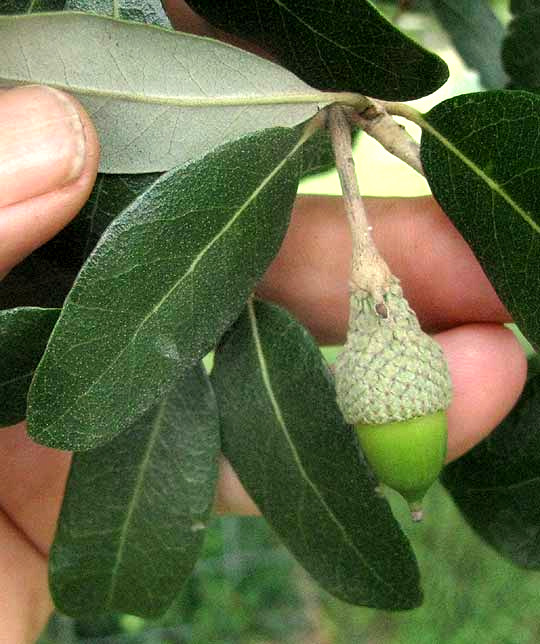
Our part of southwestern Texas is a transition zone between mostly oak-rich forests and irrigated farmland to the east, mostly pastured grasslands to the north, and Mesquite scrub, grasslands and desert to the west and south. In my local area, in the valley of the Dry Frio River, the forest is much lower and scrubbier, with much less species diversity, than the Mississippi forests I've just left. This is a very hot, dry environment, so organisms surviving here must have special adaptations.
Our native forest is dominated by just two species -- Texas Live Oaks and Ashe Junipers. Other woody species are present but, at least in my local area, those two species exercise a profound dominance.
My 1968 Trees of North America shows Live Oaks, Quercus virginiana, inhabiting the US Deep South along the Coastal Plain from about Virginia all the way into Texas, even as far west into the arid lands as here, and even into Mexico. I've never understood how the Deep South's Live Oaks, accustomed to high humidity and considerable rain, could survive in arid places like Uvalde County. Now that I'm here, I'm understanding.
Since my tree book was published in 1968 the general consensus seems to have become that we're dealing with two different species. The Live Oak back in Mississippi, Quercus virginiana, extends no farther west than eastern Texas. Here we have a different but very similar species, the Texas Live Oak, QUERCUS FUSIFORMIS, which occupies central and southern Texas, plus southwestern Oklahoma and a bit of northern Mexico. The Flora of North America admits that the two live oak species often intergrade, and individual trees can be hard to distinguish.
So, though I'd find it hard to confirm it, the Flora of North America says that the leathery-leafed, compact tree about 25 feet tall (8m) outside my back door is a Texas Live Oak. That's its silvery-bottomed leaves and long-stemmed, pointy-tipped acorns at the top of this page. Its dark, deeply fissured bark is shown below:
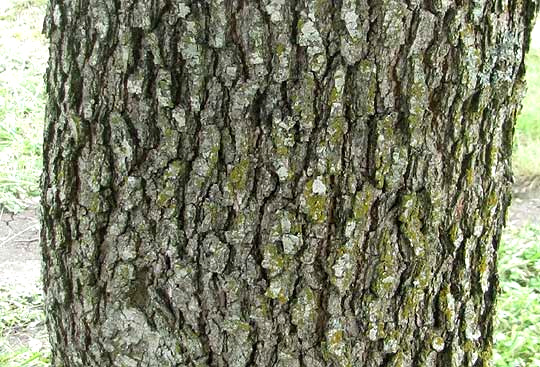
The species forms pretty, cow-friendly "parks" when the junipers are cleared from around them, as shown below:
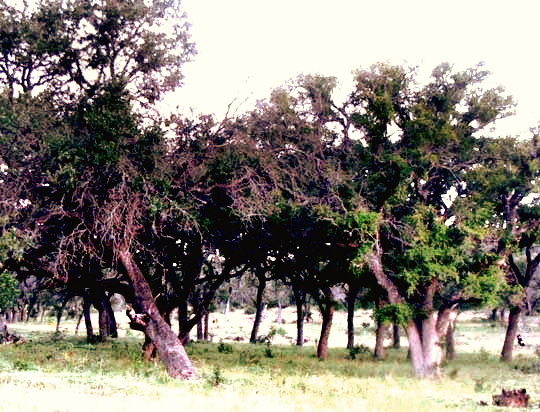
You can compare features shown there with those of a classic Live Oak back in Mississippi at http://www.backyardnature.net/n/w/live-oak.htm.
from the April 14, 2013 Newsletter issued from the Frio Canyon Nature Education Center in northern Uvalde County, southwestern Texas, on the southern border of the Edwards Plateau; elevation ~1750m (~5750 ft); N29.62°, W99.86°; USA
LIVE OAKS LOSING/ADDING LEAVES
Right now our Texas Live Oaks are doing something species, which you can see below:
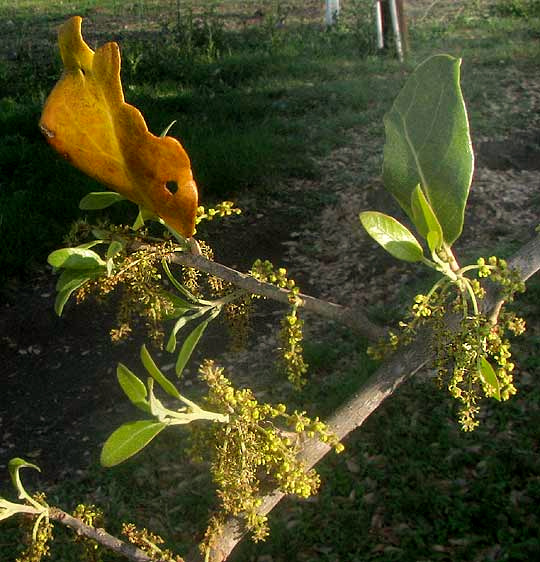
Those fuzzy, yellow items dangling from the twigs are catkins of male flowers, but that's normal for oaks. What few other deciduous trees do but all of our live oaks are doing is issuing new leaves while many of last season's leaves are just now falling. With our live oaks, it's as is fall and spring were crammed into a few days in spring. In the picture, the two large leaves toward the top are last season's, while all the smaller leaves are just now emerging from buds.
In many towns, including San Antonio to our east, live oaks are often the main street tree, and this is the time of year when falling leaves must be dealt with. Many property owners now find outside their doors what's shown below:
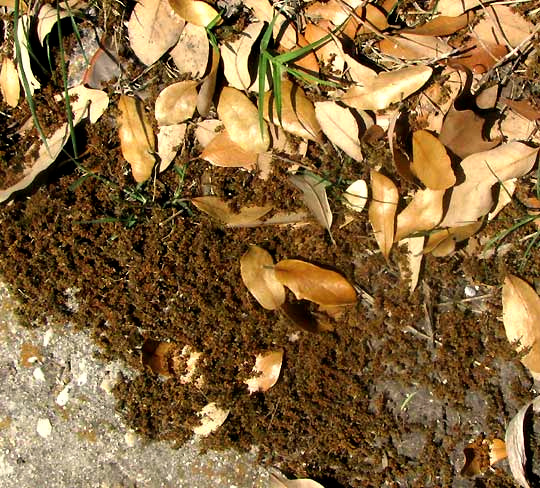
The shiny leaves are live oak leaves, and the dark brown, wormylike items are discarded catkins of male flowers, also from the live oaks. Sometimes a little rain creates considerable dams of live-oak leaves and catkins.
On leafing-out live oaks male catkins are hard to overlook, but unless you know what you're looking for you may not find female flowers, which will mature into the future acorns. They're tiny, greenish things in the axils of expanding new leaves toward the tips of new branches, shown below:
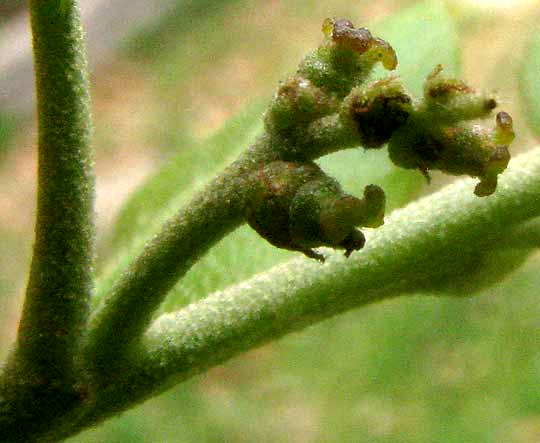
In that picture the green, vertical column at the left is a leaf petiole, so you can see how small the female flowers are. Oak female flowers bear no corolla or stamens. The three in the picture consist only of cuplike calyxes beneath spherical ovaries. Atop each ovary arise three styles, each with a sticky stigmatic area where pollen is supposed to land and germinate.
from the August 25, 2013 Newsletter issued from the Frio Canyon Nature Education Center in the valley of the Dry Frio River in northern Uvalde County, southwestern Texas, on the southern border of the Edwards Plateau; elevation ~1750m (~5750 ft); N29.62°, W99.86°; USA
BURL
A big Texas Liveoak a couple miles up the road bears a washing-machine-size burl about 15 feet up, as you can see below:
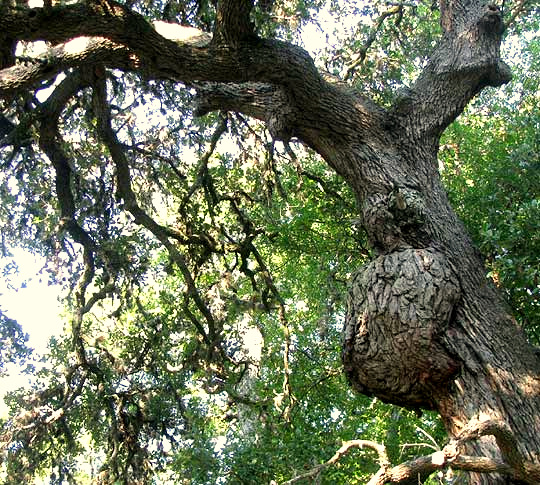
Burls are caused by stress, usually from a physical injury, or maybe a virus or fungus. Burls are like tumors in that the wood composing them grows in an uncontrolled manner. One consequence of this is that when the burl is cut across, the exposed wood grain is wildly contorted, often producing fascinating and pretty patterns. Some folks specialize in producing ornate wood products cut from burls. One reappearing motif in burl wood grain patterns is the "bird's eye," which results from buds that appeared on the growing burl and then were aborted and smothered by fast-growing wood.
from the January 26, 2014 Newsletter issued from the Frio Canyon Nature Education Center in the valley of the Dry Frio River in northern Uvalde County, southwestern Texas, on the southern border of the Edwards Plateau; elevation ~1750m (~5750 ft); N29.62°, W99.86°; USA
OAK DECLINE
In the Texas Hill Country there's Oak Wilt and Oak Decline, two different things, and both are devastating our oaks. In our more arid southwestern corner of the region, we have Oak Decline but, so far, I don't see Oak Wilt. Oak Wilt is bad just to our east, for example in San Antonio, where it's killing many old street and park trees.
In our hilly area the forest is dominated by Ashe Junipers and Texas Live Oaks, with just a handful of other species sprinkled among them, especially Texas Red Oaks, which also are suffering from Oak Decline. Oaks are so dominant in our forests that if they disappear the very nature of our woodland ecology will be altered catastrophically.
The next picture shows what Oak Decline looks like on trees beside Juniper House:
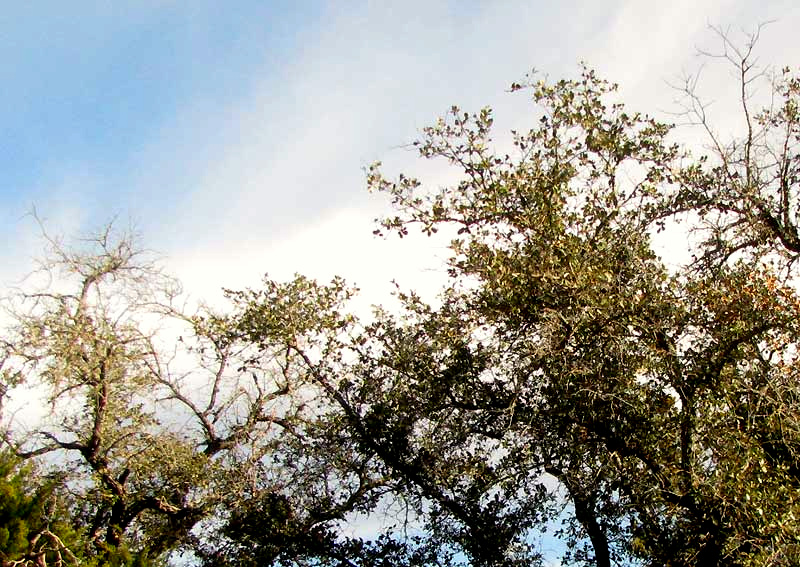
Those are the tops of Texas Liveoaks, Quercus fusiformis, which are about 20 feet tall (6m). At this season healthy trees still bear their leaves; the leaves will fall in April as new ones emerge. The thing to notice is that major branches in the trees' crowns are leafless -- dead, in fact. They were dead this summer, and as time passes more limbs die in the trees' upper part. That's the main symptom of Oak Decline: Some branches dying while others don't, but the trend is toward all of them dying. Curiously, many oaks succumbing to Oak Decline also show what's seen below:
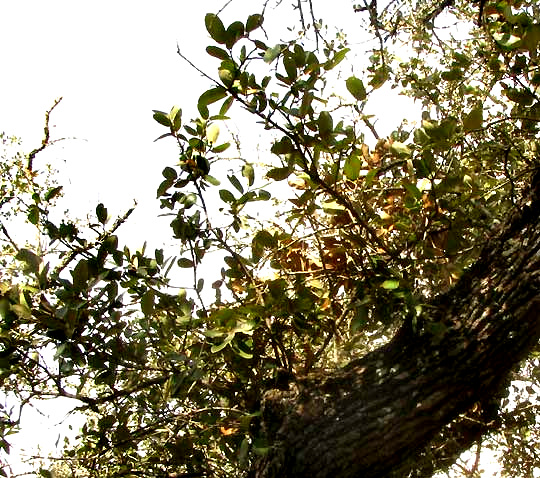
Those are new sprouts developing on the lower trunk of one of the trees shown above. As larger branches die above, new sprouts issue from the trunk close to the ground. Eventually even these will die, however. The amount of time taken for a tree to die completely depends on how much stress the tree is under, especially whether it's getting enough rain.
There's a disease organism involved, a fungus called Acremonium diospyri. However, this fungus is described as a "weak vascular pathogen," which means that it not very aggressively enters a tree's vascular system and clogs it so that water and nutrients can't get to where they're needed. The fungus becomes a serious problem only on trees already stressed, as our trees are by the drought experienced here during recent years. The disease caused by Acremonium diospyri is like measles among humans: Among healthy individuals it might be bothersome, but not deadly. Besides our Texas Live Oaks, other trees affected by Acremonium diospyri are Texas Red Oak, Post Oak, Water Oak, Willow Oak, Sycamore, Persimmon, Winged Elm, Hackberry, American Elm and Western Soapberry.
Every liveoak on our hill shows signs of Oak Decline, but those growing along the Dry Frio River are in good shape, apparently because they're getting adequate water. There's some indication that the fungus can be spread between trees by bark beetles. Confirming the presence of the fungus is hard, even for experts, so I'm only guessing that it's contributing to Oak Decline here.
Texas A&M University's Plant Disease Handbook suggests these steps for reducing die-back of liveoaks from Oak Decline: 1) Identify the problem; 2) Reduce stress on the trees; 3) Provide plenty of fertilizer and water; 4) Remove dead limbs on tree; 5) Don't import wood from areas with Oak Decline, and; 6) Plant trees other than those vulnerable to the Oak Decline fungus.
In our area of severe ongoing drought, on one hill among many with thousands of declining liveoaks, all we can do is to watch the decline take place, and hope for rain.